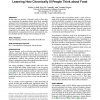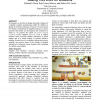218 search results - page 13 / 44 » Smart Indicators on Learning Interactions |
CHI
2006
ACM
14 years 8 months ago
2006
ACM
In this paper, we describe a formative study to learn how one chronically ill population thinks about food, mentally organizes food, and interprets consumption-level icons. We fou...
ACE
2004
13 years 9 months ago
2004
An examination of some recent programming texts indicates that the complexities of modern programming languages and environments have replaced the study of algorithms and programm...
ACMIDC
2008
13 years 9 months ago
2008
In this paper we describe the design and initial evaluation of a tangible computer programming exhibit for children on display at the Boston Museum of Science. We also discuss fiv...
CHI
2002
ACM
14 years 8 months ago
2002
ACM
Tangible programming elements offer the dynamic and programmable properties of a computer without the complexity introduced by the keyboard, mouse and screen. This paper explores ...
COGSCI
2010
13 years 7 months ago
2010
People are remarkably smart: They use language, possess complex motor skills, make nontrivial inferences, develop and use scientific theories, make laws, and adapt to complex dyna...


